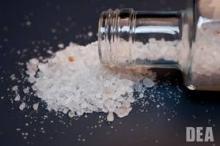The first-ever nationwide strike on the designer drug industry resulted in 90 arrests and the seizing of 5 million drug packets and more than $36 million in cash, according to the U.S. Drug Enforcement Administration.
"Although tremendous progress has been made in legislating and scheduling these dangerous substances, this enforcement action has disrupted the entire illegal industry, from manufacturers to retailers," said DEA Administrator Michele M. Leonhart of the strike, which is called Operation Log Jam.
Synthetic cathinones (with street names like "bath salts" or "plant food") and synthetic cannabinoids (better known as "Spice" and "K2") have become increasingly popular in recent years, especially among young adults.
Many of the drugs come with the disclaimer "Not for human consumption," and they’re marketed at retail stores, head shops, and online.
Some are sold in hookah bars as "hookah cleaner," said Mark Ryan, director of Louisiana Poison Center and a national authority in the field.
"But in fact, they’re incredibly dangerous, with users having unpredictable – and sometimes deadly – reactions to these substances," Ms. Leonhart said in a news conference.
Earlier in July, President Barack Obama signed into law the Food and Drug Administration Safety and Innovation Act, permanently placing 26 of the substances used in designer drugs into schedule I of the Controlled Substances Act.
Yet, the manufacturers continually change the formula to avoid the law.
The sophistication of the designer drug industry has grown over the past 2 years, and such drugs are "an emerging problem," said Ms. Leonhart, "I put them up there with prescription drugs."
In just 1 year, calls to poison centers regarding synthetic cannabinoids has more than doubled, and calls regarding synthetic cathinones has increased 24-fold, she said.
In 2010, poison control centers responded to roughly 3,200 calls related to designer drugs, according to the DEA. In 2011, that number jumped to more than 13,000 calls. Some 60% of the cases involved patients aged 25 years and younger, according to the DEA.
Mr. Ryan of the Louisiana Poison Center said that for the past 3 years, he has spent 2-3 hours every day handling problems related to synthetic drugs. Many of the calls have been from emergency physicians bewildered by their patients’ symptoms.
The drugs have unpredictable effects, and can cause hallucinations, paranoia, coma, and sometimes death. And because of their varying formulations, the drugs have no known antidotes, and their long-term effects are not known.
All physicians can do is "treat the patient, not the poison," said Mr. Ryan.
Meanwhile, there’s no quick, easy test to identify the drugs, said Dr. Cathleen Clancy, an emergency physician and associate medical director of the National Capital Poison Center in Washington, D.C.
"What we get is an agitated patient who says that they have ingested something, and sometimes they don’t even tell you that," she said in an interview.
In one of the few published case studies, Dr. Joanna Cohen and colleagues presented three cases involving teenagers aged 16-18 years who had used synthetic cannabinoids (synthetic marijuana). The investigators cautioned that "given the sensitivity of the developing brain and association between early cannabis use and psychosis, adolescent use of these new synthetic cannabinoids is particularly concerning" (Pediatrics 2012;129:e1064-7).
So what should physicians tell their patients?
"Explain to them that when they take these drugs, they’re being guinea pigs. These are adaptations, and we don’t know how they’ll affect the [users]. I think if people understood that, they’d be less willing to try those drugs," said Dr. Clancy.
Operation Log Jam was conducted by the DEA and U.S. Immigration and Customs Enforcement, with assistance from Internal Revenue Service Criminal Investigations, the U.S. Postal Inspection Service, U.S. Customs and Border Protection, the Federal Bureau of Investigation, the Food and Drug Administration’s Office of Criminal Investigation, and local and state law enforcement officials in more than 109 U.S. cities.


